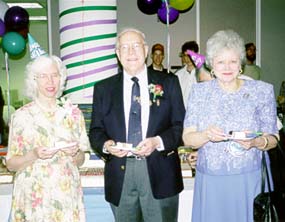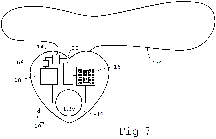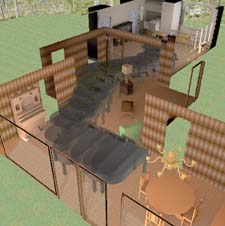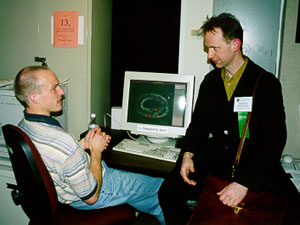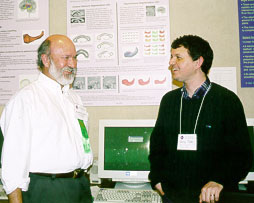Congratulations to...
Frederick P. Brooks Jr., Kenan professor, who
was elected to the National Academy of Sciences.
Maxim Garber and Vincent Scheib,
graduate students, who each received $800
scholarships to attend the 2001 Game Developers
Conference in San Jose, Calif., in March.
Bil Hays, network manager, Catherine
Perry, accounting manager, and Claire
Stone, publications and publicity manager, who
each received "Star Heel" awards from UNC for
excellence in their work for the department.
William Jiang, Windows systems administrator,
who received an award from UNC recognizing his
outstanding contributions to information technology
support.
Undergraduates John Ehrhardt, Serge
Gagarin, and Bennett Rogers, who were
inducted into Phi Beta Kappa on 30 April.
And to our August and December 2000
graduates:
Doctor of Philosophy
Timothy D. Culver, "Computing the Medial Axis
of a Polyhedron Reliably and Efficiently" (adviser:
Dinesh Manocha).
Stefan A. Gottschalk, "Collision Queries Using
Oriented Bounding Boxes" (Ming C. Lin and Dinesh
Manocha).
Brian C. Ladd, "Lingua Graphica: A Language
for Concise Expression of Graph-Based Algorithms"
(John B. Smith).
Master of Science
August: Matthew J. Waibel
December: William V. Baxter III*, Alex B.
Blate, Yanlin Hou, Yuquan Jiang, Man-Chi Leung,
Xiaosi Li, David T. Marshburn II, David E. Ott*, Bian
Wu, Paul A. Yushkevich*
*Continuing on to Ph.D. at UNC
B.S. Mathematical Sciences (CS Option)
Neda Crigler, Eric J. Edge, Michael J. Hirschel**,
Amarish D. Khopkar, Daniel C. McPherson, Joseph D.
Russ Jr., Harold D. Ryel-Lindsey, Daniel A. Sarisky*,
Daniel R. Williams
*With Honors **With Highest
Honors
Staff Promotions and Transfers
Mike Carter transferred to the position of
Electronics Technician III in April.
Linda Houseman transferred to the position of
Computing Consultant I in February.
Claire L. Stone was promoted to a higher grade
classification of Information and Communications
Specialist, as of 26 March.
Mike Stone was promoted to an Electronics
Technician IV, effective 26 March.
Welcomes and Farewells
New Faculty
Sarang Joshi, adjunct assistant professor
(assistant professor, Biomedical Engineering and
Radiation Oncology, UNC), D.Sc. 1998, Washington
University. Image analysis; medical image processing;
computer vision; computational anatomy.
Sarang joined UNC last summer and began a joint
appointment with our department in December. He is a
member of the Medical Image Display and Analysis
Group (MIDAG). Sarang is currently involved in
several MIDAG projects concerning medical image
registration and object and shape based medical image
analysis.
New Students
Jay Aikat, Angus Antley, Jun Jia, Yuanxin Liu,
Haolong Ma, and Daniel Wiegand
Postdoctoral Researchers
Robert-Paul Berretty joined us in January
after receiving his Ph.D. in computer science in
December from the Institute of Information and
Computing Sciences at Utrecht University in the
Netherlands. His research interests are in
computational geometry and robotics. Robert-Paul is
working with Jack Snoeyink, professor.
Joël Goossens joined us in April to work with
Sanjoy Baruah, associate professor. He received his
Ph.D. in computer science from the Université Libre
de Bruxelles in Belgium in 1999. His research
interests include scheduling algorithms for real-time
systems.
Young J. Kim joined us in January to work with
Ming Lin, associate professor, and Dinesh Manocha,
professor, on the study of haptic computation. He
received his Ph.D. in computer science in August 2000
from Purdue University.
Susan Paulsen joined us in January. She works
with Lars Nyland, research associate professor, Jan
Prins, associate professor, and William Wright,
research professor emeritus, on the Self-Scheduling
N-body Algorithms project. She received her Ph.D. in
zoology and genetics in 1992 from Duke University.
New Staff
Charles Bauserman, Windows systems
administrator, joined the Computer Services staff in
March. He previously worked in the School of Medicine
at UNC.
Delphine Bull, administrative assistant to
faculty members Stephen M. Pizer and Guido Gerig and
to MIDAG, joined us full time in March, after working
as a temporary since January. She previously worked
for Nasera Corp. She is working on her B.A. in
management and society at UNC.
Paul Morris, administrative assistant, joined
us full time in December, after working as a
temporary since September. He provides support to
faculty members Frederick P. Brooks Jr., Russell M.
Taylor II, and Mary Whitton. Paul has a B.A. in
religion from the University of the South.
Jenni Styron, office assistant, joined us full
time in January as an assistant to several faculty
members, after working as a temporary since August.
Jenni majored in history at UNC.
Thanks and farewell to . . .
Laura Schutz Duggan, computing consultant, who
left in February to be home with her new daughter
(see "Family Matters").
She had worked with the department since November
1998, providing general technical support, systems
support on Macintoshes, and backups of UNIX and
Macintosh systems.
Lynne Duncan (M.S. 1985), systems
programmer/administrator for the Microelectronic
Systems Laboratory, who joined UNC's Academic
Technology and Networks office in January. She had
been with us since July 1985.
Nicole Harper, administrative assistant to
faculty members Stephen M. Pizer and Guido Gerig and
to MIDAG, who joined Quintiles Transnational in
Research Triangle Park, N.C., in November. Nicole had
been with us since October 1997.
Lori Rodman, computing consultant, who joined
UNC's Kenan Flagler Business School in April. Her new
position will allow her to broaden her skills as a
computing consultant. Lori had been with the
department since December 1993.
Betty Solorzano, office assistant, who left in
May to return to Miami, Fla., after her husband's
graduation from UNC's Kenan Flagler Business School.
She had been with us for two years.
A key challenge of motion planning is the difficulty
of converting 3D representations of the robot and the
environment into a characterization of the higher
dimensional (6D or higher) space of possible
positions and orientations. Previous approaches that
have worked well in practice use probabilistic
roadmap algorithms, but problems arise when the robot
needs to move through "narrow passages"--constricted
portions of the environment--because it is unlikely
that a sufficient number of configurations can be
generated randomly in these narrow passages.
Currently, the researchers are investigating a
potential field approach for generating the initial
estimated path, whereby the robot is repelled from
the walls by simulated forces. They are also
considering ways to use a more detailed geometric
analysis to determine good orientations for the robot
as it travels through a scene. For more on motion
planning research, see:
www.cs.unc.edu/~geom/planning/.
The group's faculty leaders have received several new
grants in recent months, including:
The ONR and Intel grants will support the development
of computational approaches to enable real-time
physically based modeling and interaction between a
user and virtual objects.
Recent Conferences
RTSS 2000
UNC was well represented by faculty, students, and
alumni at the 21st annual IEEE Real-Time Systems
Symposium (RTSS), which was held in late November
2000 in Orlando, Fla. RTSS is the premier technical
conference for real-time systems research. Kevin
Jeffay, S. S. Jones professor, chaired the
program committee, which included Sanjoy
Baruah, associate professor, and alumni
Stephen Goddard (Ph.D. 1998) of the University
of Nebraska, and Mark Moir (Ph.D. 1996),
formerly of the University of Pittsburgh, now at Sun
Microsystems Laboratories. Mark also co-authored a
paper with fellow alumnus Srikanth Ramamurthy
(Ph.D. 1997) of IBM Pittsburgh Lab (formerly
Transarc), entitled "Static-Priority Periodic
Scheduling on Multiprocessors." Graduate student
John Carpenter presented the paper, "A
Framework for Achieving Inter-Application Isolation
in Multiprogrammed Hard-Real-Time Environments,"
which was co-authored by Sanjoy Baruah, and
Giuseppe Lipari of the Scuola Superiore S. Ana
in Pisa, Italy. Giuseppe was a visiting scholar at
UNC a year ago. Presentations describing work in
progress were made by Stephen Goddard, and by
graduate students Anand Srinivasan (M.S. 2000)
and Philip Holman, who each collaborated with
Jim Anderson, associate professor. For more on the
conference, see
www.cs.unc.edu/~jeffay/meetings/rtss00/.
UNC's close association with RTSS continues this fall
when the symposium moves to London, England. Kevin
Jeffay is general chair of the conference, and Sanjoy
Baruah and Jim Anderson are on the program committee.
I3D 2001
In March, the Graphics and Image Cluster hosted the
ACM 2001 Symposium on Interactive 3D Graphics (I3D)
in Research Triangle Park, N.C. Mary Whitton,
research assistant professor, chaired the symposium,
and a number of faculty and staff served on the
organizing committee. Many current and former
students also participated.
Gary Bishop (Ph.D. 1984), associate professor,
and Mark Mine (Ph.D. 1997) of Disney
Imagineering chaired paper sessions. Alumni with
papers included Subodh Kumar (Ph.D. 1996) of
Johns Hopkins, Marc Levoy (Ph.D. 1989) of
Stanford, Leonard McMillan (Ph.D. 1997) of
MIT, and Amitabh Varshney (Ph.D. 1994) of
Maryland-College Park. UNC faculty and students had
several papers (see "Recent
Publications"). Bill Verplank of the
Center for Computer Research in Music and Acoustics
at Stanford presented the keynote address, "From
Haptics to Music: Experiences in Physical Interaction
Design." At a dinner, novelist Andrew Glassner
(Ph.D. 1988) spoke on "Graphics, Stories, and Games."
The department hosted a reception and evening of
demos in Sitterson Hall. Conference attendees enjoyed
a North Carolina-style barbecue dinner, catered by
Bullock's Barbecue of Durham, and tried out a number
of graphics demos including Avatar Reconstruction for
Interactive Synthetic Environments (ARISE),
Interactive Haptic Painting with 3D Virtual Brushes
(dAb), Hardware-Accelerated Voronoi Computation
(HAVOC), Interactive Multiresolution Modeling and 3D
Painting with a Haptic Interface (inTouch), Light
Field Mapping, nanoManipulator, Proximity Information
from Voronoi Techniques (PIVOT), Office of the Future
and Tele-Immersion, Redirected Walking,
Six-Degree-of-Freedom Haptic Rendering, and Voronoi-Based
Motion Planning. Handouts in PDF format for these and
many other projects are available at
www.cs.unc.edu/Research/ProjectSummaries/.
For more information about I3D 2001, see
www.siggraph.org/conferences/i3d/.
Contracts and Grants
Boom in Industry Funding for the DiRT
Group
In the past year, researchers in the Distributed and
Real-Time Systems (DiRT) group have succeeded in
obtaining significant industry funding to help
support a variety of Internet-related projects.
Dell Computer Corp.'s STAR (Strategic Technology and
Research) program, has awarded Kevin Jeffay,
S. S. Jones professor, Don Smith (Ph.D. 1978),
research professor, and Russell M. Taylor II
(Ph.D. 1994), research associate professor, a $25,000
grant to help fund the networking component of an
outreach project to introduce public school students
to nanotechnology (see article below). The goal is
both to provide additional funding for
nanoManipulator outreach efforts and to use the
resulting "virtual field trips" as vehicles for
furthering multimedia networking research.
An IBM Shared University Research Grant awarded last
October to Kevin, Don, and Paul Jones of
Information and Library Science, is providing
$250,000 worth of equipment to support networking and
Internet technologies research. Two-thirds of the
equipment is for servers to run the information
repository for ibiblio, UNC's new digital library
(www.ibiblio.org).
Paul is its chief architect. With our one-third of the award, the
department has received several IBM Netfinity
computers and servers that are being used to collect
and analyze network trace data. Kevin, Don, and
students are using the resulting data to research how
the nature of Internet traffic evolves over time and
how the congestion control and quality-of-service
mechanisms proposed for the Internet must evolve in
turn.
Kevin and Don also received an $80,000 equipment
grant from Sun Microsystems as part of Sun's Academic
Equipment Grant program. The Sun systems are
Enterprise servers that also will be used to store
and process network traces. Together, the Sun and IBM
grants have raised the storage capacity of the DiRT
group's research server farm to multiple terabytes of
secondary storage. A multi-year Intel equipment grant
also continues to provide support.
Related to the traffic monitoring work is new
research on the construction of empirical models of
application-level protocols such as HTTP. Cisco
Systems has donated $85,000 to the department to
support the construction of application-level traffic
models from trace data. These models also contribute
to the design of advanced congestion control
mechanisms for the Internet and are being used by
networking researchers both on and off the UNC
campus.
Finally, the department has received several graduate
fellowships to support networking-related research.
Students of Kevin Jeffay and Ketan Mayer-Patel,
assistant professor, have received awards
through the North Carolina Networking Initiative's
Graduate Fellowship Program and the related
Cabletron/Aprisma Graduate Fellowship. These programs
provide support for graduate student research in the
development of middleware for applications to be used
in next-generation networks. In addition, MCNC and
Lucent Corp. have provided student support for
network monitoring and traffic analysis research.
NSF and Industry Grants Fund Nanotechnology
Outreach Project
Funding from the National Science Foundation (NSF)
and from several corporations, is allowing
researchers at UNC to introduce nanotechnology--the
exploration and manipulation of objects at the atomic
and molecular levels--to middle school and high
school students. Participants in the first two years
will be students at two Chapel Hill-area schools. In
the third year, the project will expand to include
hundreds of students at schools throughout North
Carolina and in Iowa.
Gail Jones, associate professor of science
education, is the principal investigator on the
three-year NSF grant, and Richard Superfine,
associate professor of physics, and Russell M.
Taylor II (Ph.D. 1994), research associate
professor of computer science, are co-investigators.
See the related article (above) for information on
the industry-funded grants.
Students will use the nanoManipulator system to
manipulate and to "feel" the 3D image of a virus on a
computer screen--an image projected from an atomic
force microscope located at UNC through an Internet
connection. The sensation of "feeling" DNA and
viruses adds a dimension to investigations and allows
discussion between scientists and students on the
stickiness, viscosity, or strength of the virus's
protein coat.
The researchers will study the effectiveness of
nanotechnology in helping students acquire and gain
interest in scientific knowledge. "Many students have
never had a scientist visit the classroom," said Gail
Jones. "We believe this interaction, plus the
technology component, will inform their knowledge of
the processes and excitement surrounding scientific
study."
The researchers conducted two exploratory studies
with the nanoManipulator at a local high school in
1998 and 1999. Russell Taylor said that feedback from
students indicated that they began to see science as
an enjoyable and rewarding pursuit. Richard Superfine
observed, "The students glow when they 'feel' their
first virus or DNA, and they immediately understand
why the scientists love discovery so much."
(www.cs.unc.edu/Research/nano/)
Foundation of Hope Grant
Guido Gerig, Taylor Grandy professor of
computer science and psychiatry, has received a grant
from the Foundation of Hope for "Neonatal Cerebral
Ventricle Shape from 3D Ultrasound in
Neuro-Psychiatric Disorders." He and John Gilmore,
associate professor of psychiatry, are using 3D
ultrasound to study the cerebral ventricle volume of
premature infants. Enlargement of the cerebral
lateral ventricles is the most consistent
neurostructural abnormality observed in schizophrenia
and it is thought to arise during early brain
development. Ventricle enlargement in premature
infants is associated with poor neurodevelopmental
outcome. The researchers hope that by studying
ventricle volume, they can identify children at risk
for schizophrenia and other neurodevelopmental
disorders and that they can also increase
understanding of the causes of neurodevelopmental
disorders associated with ventricle enlargement.
MERL Gives $50,000 Grant
Mitsubishi Electric Research Laboratories (MERL) has
awarded a $50,000 grant to the department. The gift
will support the projector-based graphics and vision
research being pursued by Henry Fuchs,
Federico Gil professor, Gregory F. Welch
(Ph.D. 1997), research assistant professor, and
Herman Towles, senior research associate.
Recent Publications
Amaro, C., S. Baruah, T. Marlowe, and A. Stoyenko.
"Non-Preemptive Scheduling to Maximize the Minimum
Intercompletion Time," Journal of Combinatorial
Mathematics and Combinatorial Computing, Vol.
34, 2000, 33-50.
Anderson, J., and P. Holman. "Efficient Pure-Buffer
Algorithms for Real-Time Systems," Proc. Seventh
International Conference on Real-Time Computing
Systems and Applications, December 2000, 57-64.
Anderson, J., and Y.-J. Kim. "A New Fast-Path
Mechanism for Mutual Exclusion," Distributed
Computing, 14(1), January 2001, 17-29
Anderson, J., M. Moir, and S. Ramamurthy. "A Simple
Proof Technique for Priority-Scheduled Systems,"
Information Processing Letters, 77(2-4), 28
February 2001, 63-70.
Anderson, J., and A. Srinivasan. "Pfair Scheduling:
Beyond Periodic Task Systems," Proc. Seventh
International Conference on Real-Time Computing
Systems and Applications, December 2000, 297-306.
Ehmann, S., and M. C. Lin. "Accelerated Proximity
Queries Between Convex Polyhedra By Multi-Level
Voronoi Marching," Proc. IEEE/RSJ International
Conference on Intelligent Robots and Systems 2000,
2101-2106.
Erikson, C., D. Manocha, and W. V. Baxter III. "HLODs
for Faster Display of Large Static and Dynamic
Environments," Proc. ACM 2001 Symposium on
Interactive 3D Graphics, March 2001, 111-120,
255; also Department of Computer Science technical
report TR00-012.
Goossens, J., and S. Baruah. "Multiprocessor
Algorithms for Uniprocessor Feasibility Analysis,"
Proc. International Conference on Real-Time
Computing Systems and Applications, December
2000.
Hoff III, K. E., A. Zaferakis, M. C. Lin, and D.
Manocha. "Fast and Simple Geometric Proximity Queries
Using Graphics Hardware," Proc. ACM 2001 Symposium
on Interactive 3D Graphics, March 2001, 145-148,
259.
Hudson, T., D. H. Sonnenwald, K. Maglaughlin, M. C.
Whitton, and R. Bergquist. "Enabling Distributed
Collaborative Science: The Collaborative
nanoManipulator," Video Proceedings of 2000 ACM
Conference on Computer-Supported Cooperative Work,
December 2000.
Hudson, T. C., M. C. Weigle, K. Jeffay, and R. M.
Taylor II. "Experiments in Best-Effort Multimedia
Networking for a Distributed Virtual Environment,"
Proc. Multimedia Computing and Networking,
January 2001, 88-98.
Lipari, G., J. Carpenter, and S. Baruah. "A Framework
for Achieving Inter-Application Isolation in
Multiprogrammed, Hard Real-Time Environments,"
Proc. IEEE Real-Time Systems Symposium,
November 2000, 217-226.
Lok, B. "Online Model Reconstruction for Interactive
Virtual Environments," Proc. ACM 2001 Symposium on
Interactive 3D Graphics, March 2001, 69-72, 248; also
Computer Graphics World, February 2001, 17.
Paulson, S., A. Helser, M. Buongiorno Nardelli, R. M.
Taylor II, M. Falvo, R. Superfine, and S. Washburn.
"Tunable Resistance of a Carbon Nanotube-Graphite
Interface," Science, Vol. 290, December 2000,
1742-1744.
Popescu, V., and A. Lastra. "The Vacuum Buffer,"
Proc. ACM 2001 Symposium on Interactive 3D
Graphics, March 2001, 73-76, 249.
Seeger, A., A. Henderson, G. L. Pelli, M. Hollins,
and R. M. Taylor II. "Haptic Display of Multiple
Scalar Fields on a Surface," Proc. Workshop on New
Paradigms in Information Visualization and
Manipulation, November 2000, 33-38.
Sonnenwald, D., R. Bergquist, K. Maglaughlin, E.
Kupstas Soo, and M. Whitton. "Designing to Support
Scientific Research Across Distances: The
nanoManipulator Environment," Collaborative
Virtual Environments, E. Churchill, D. Snowdon,
and A. Munro, eds., London: Springer Verlag, 2001,
202-224.
Styner, M., G. Gerig, C. Brechbühler, and G. Szekely.
"Parametric Estimate of Intensity Inhomogeneities
Applied to MRI," IEEE Transactions on Medical
Imaging, 19(3), 2000, 153-165.
Welch, G., G. Bishop, L. Vicci, S. Brumback, K.
Keller, and D. Colucci. "High-Performance Wide-Area
Optical Tracking--The HiBall Tracking System,"
Presence: Teleoperators and Virtual Environments,
10(1), January 2001.
Alumni News
M.S. and Ph.D. Alumni
Jim Begley (M.S. 1993) has joined Coactive
Systems Corp. as a senior software developer.
(JimBegley@yahoo.com)
Steven Bellovin (Ph.D. 1982) has been elected
to the National Academy of Engineering.
(smb@research.att.com)
Sam Black (M.S. 1986) is at Pixar Animation
Studios, where he is developing RenderMan and
designing future renderers. He was recently cast as a
voice performer in Pixar's next movie, Monsters,
Inc., which will be released this November. In
his spare time, Sam builds cabinetry, flies anything
he can get his hands on, and instructs airplane and
hot-air balloon pilots.
(penguin@mahasamatman.com)
Randy Brown (M.S. 1990) joined the Research
Triangle Institute (RTI) in Research Triangle Park,
N.C., in January as a senior research engineer. He
previously worked for SouthPeak Interactive, whose
Video Reality(TM) technology and Profiler(TM) product
line have been purchased by RTI. Randy is one of the
creators of the Profiler products.
(rbrown@rti.org)
Tim Culver (Ph.D. 2000) has joined think3 as a
software developer. The company, located near Boston,
Mass., makes 3D CAD software for mechanical
engineering and industrial design.
(culver@acm.org)
Victoria Interrante (Ph.D. 1996) has been
awarded the McKnight Land-Grant Professorship, a
distinguished junior-level professorship at the
University of Minnesota, where she is an assistant
professor in the Department of Computer Science and
Engineering. (interran@cs.umn.edu)
Robert Keeler (M.S. 1980) has received a
$10,000 unrestricted grant-in-aid from the Whiting
Foundation. The grant recognizes the accomplishments
of writers in the early years of promising careers.
Two of Robert's poems appear in the Spring 2001 issue
of Ploughshares.
(robert.j.keeler@ieee.org)
David Luebke (Ph.D. 1998) has received a
CAREER award from NSF and a University Teaching
Fellowship from the University of Virginia where he
is an assistant professor.
(luebke@cs.virginia.edu)
Mark Moir (Ph.D. 1996) is currently a staff
engineer at Sun Microsystems Laboratories in
Burlington, Mass. (Mark.Moir@sun.com)
Daniel Palmer (Ph.D. 1996) has been granted
tenure and promoted to associate professor at John
Carroll University in Cleveland, Ohio. He is in the
Mathematics and Computer Science Department. He and
his wife also have a new daughter (see "Family Matters").
(dpalmer@jcu.edu)
Family Matters
Jenna Grace Anderson was born on 23 December
2000 in Kirkland, Wash., to George (Chip) Anderson
(B.S. MSci. 1987) and Sally Noecker Anderson.
(chipa@stockcharts.com)
Macie Helena Brandt was born on 17 April 2001
in Boulder, Colo., to Andrew Brandt (M.S. 1993) and
Lisa Brandt. She has an older brother, Colton (2).
(brandt@axiswest.com)
Graham Thompson Certain was born on 3 March
2001 in Seattle, Wash., to Andrew Certain (B.S. MSci.
1992) and Margaret Certain.
(certain@manifoldgraphics.com)
Samantha Elanor Duggan was born on 1 March
2001 in Cary, N.C., to Adam Duggan (M.S. 1995) and
Laura Schutz Duggan, former computing consultant for
the department. (adam@logicalsky.com)
Aneesha Manocha was born on 23 March 2001 in
Chapel Hill, N.C., to Dinesh Manocha, professor, and
Ming Lin, associate professor. She has an older
sister, Aninda (3). (dm@cs.unc.edu,
lin@cs.unc.edu)
Sydney Kaitlin McDaniel was born on 30 April
2001 in Durham, N.C., to Jason McDaniel and Candice
McDaniel, former receptionist for the department. She
has an older sister, Selina (2).
Michael Benjamin Menges was born on 8
September 2000 to John Menges (M.S. 1990) and Nancy
Menges. He has three siblings: Nathaniel (12), Lewis
(9), and Amelia (3). (john_menges@hp.com)
Emily Grace Xiaoyun Palmer was born on 24
December 1999 in China and joined the family of
Daniel Palmer (Ph.D. 1996) and Diane Palmer on 22
November 2000. (dpalmer@jcu.edu)
UNC is an Equal Opportunity/Affirmative Action
Institution.
